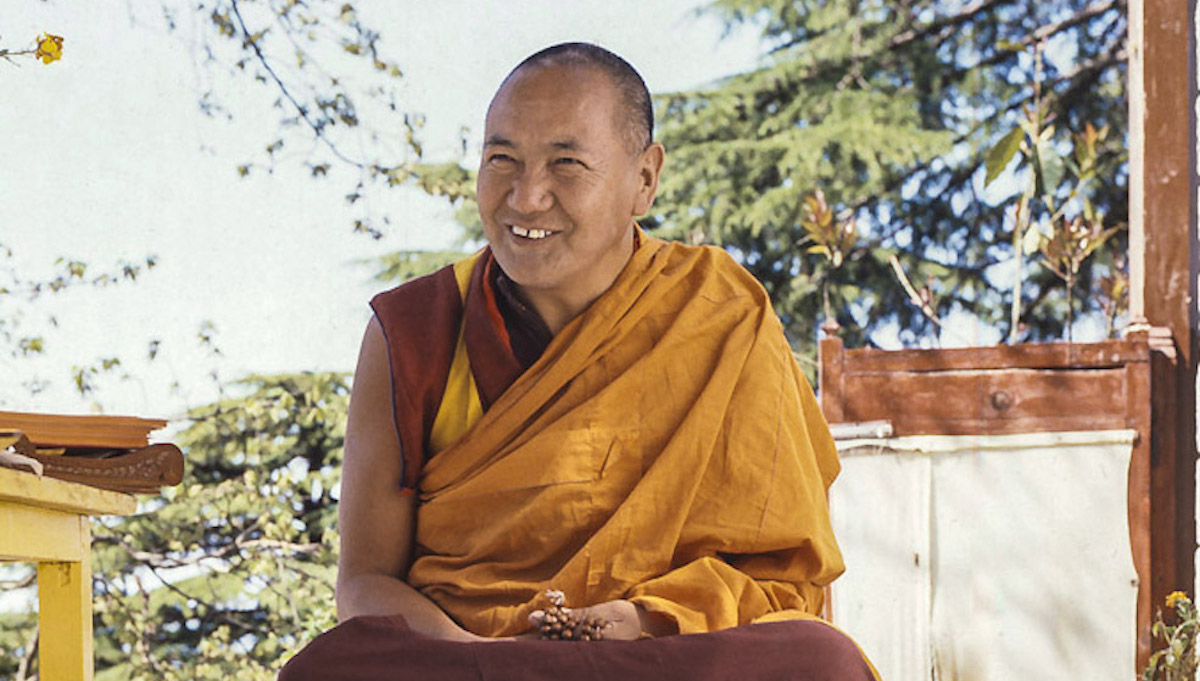From a talk offered by Lama Yeshe to the fledgling Western sangha as part of a series of talks given at Tushita Retreat Centre in Dharamsala, India in April, 1982 during the first Enlightened Experience Celebration. Edited by Nicholas Ribush and published by LYWA in Advice for Monks and Nuns. Multimedia presentation created by Megan Evart. May the Sangha flourish in the ten directions for the benefit of all sentient beings!
It is important that we consider how to present Dharma in the West. You can’t just say, ‘‘Oh, this director invited me to come and give teachings. OK, I’ll just go.’’ This has happened many times, but I’m not sure that it’s appropriate. Therefore, I wanted to say a little about education at Nalanda Monastery.
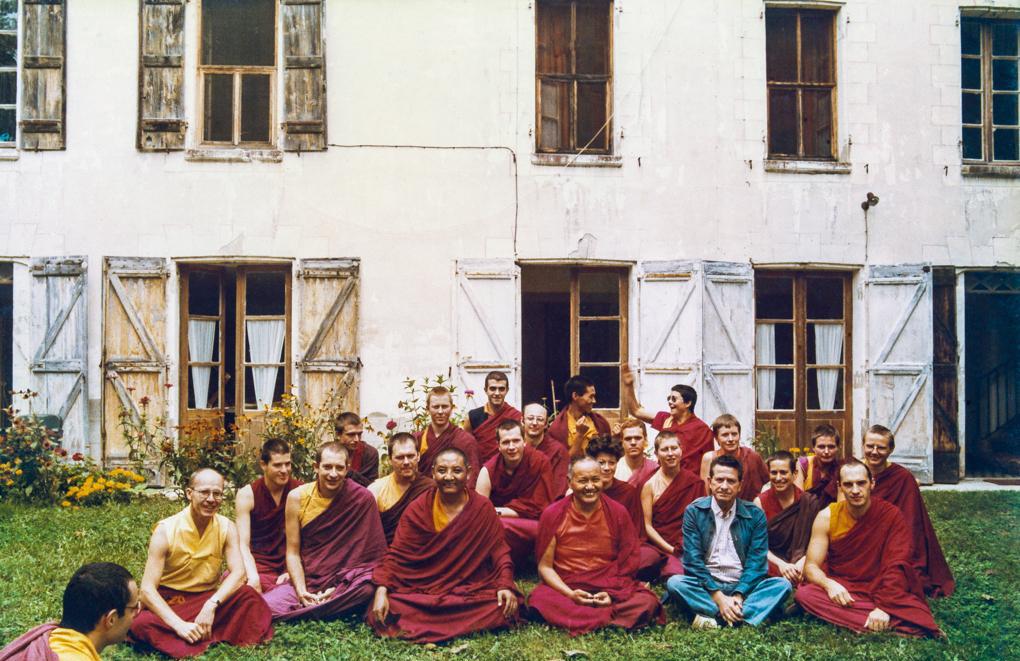
What is the purpose of Nalanda Monastery? It is a center for education, for Buddhist studies. Ideally, this means that eventually all the Sangha will become teachers. Come on! I want you to understand this. Now, being a teacher doesn’t mean only being an intellectual words teacher. There are many different ways in which you can teach. Generally, however, I expect everybody to be well educated. There is a great demand for teachers in our centers; we are very short of them. Are you aware of this or not? Everybody should know this. Then you will put more energy into trying to benefit others instead of being lazy. The world’s need for Dharma teachers is great.
The way this should work is that centers that need teachers should send their requests to the monastery and the abbot and gekyö should decide who goes out to teach. That’s a good idea; it prevents people from doing their own individual trips. Of course, the center director can specify the qualifications or even the person required—‘‘He or she is best for us because of the way we communicate’’—something like that. For people to do their own trip is not so good. Also, this is not some kind of competition; we are just trying to be as beneficial as possible.
This is not some kind of competition; we are just trying to be as beneficial as possible.
Lama Yeshe
I feel sometimes that Western teachers are more suitable for Western beginners. They are oriented to the culture and may be more acceptable to new students: ‘‘This is just what I need; I can use this.’’ We should encourage Westerners to do this kind of thing. Of course, Tibetan lamas can still come to give advanced teachings, but there are limitations to this as well. Therefore, we should hurry to educate ourselves well so that we can be of maximum benefit to others.
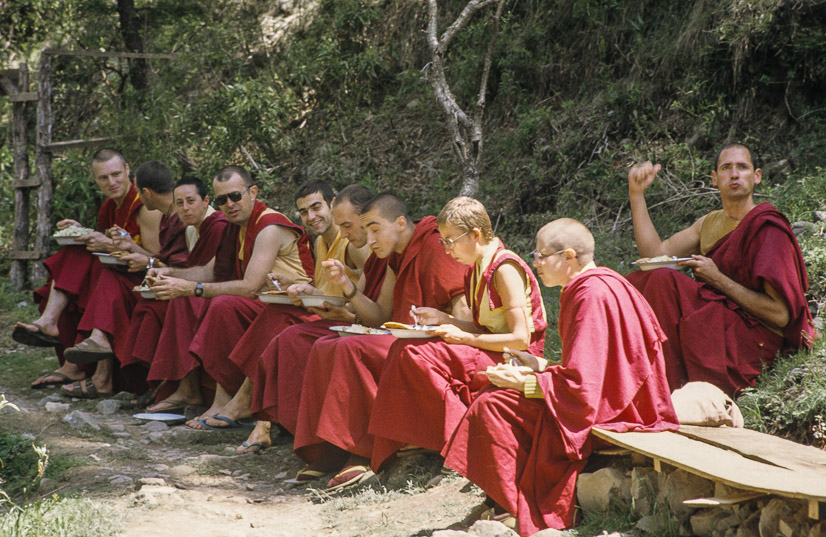
In our Sangha community, many students are already experienced in giving lam-rim courses. They have been teaching and I’m very happy about that. They are growing. Some Sangha members have intuitively understood that they should teach; I didn’t have to push them. But others don’t understand that they should teach and worry about it: ‘‘Lama said everybody has to teach. How can I possibly become a teacher?’’ Don’t worry. Whatever your ability, just do as much as you can with your life. To my way of thinking, that’s good enough. You don’t necessarily have to push yourself to accumulate intellectual knowledge. We have room for people to serve the Buddhadharma in many different ways.
Whatever your ability, just do as much as you can with your life.
Lama Yeshe
In the future, if we organize the monastery situation well, benefiting others through your education will also provide your bread and butter. Do not feel that, just because you cannot take care of yourself at the moment, your life as a Tibetan Buddhist monk or nun will always be economically difficult. That kind of mind arises sometimes; it’s not so good. It’s quite right to think about the situation, but many people in the world need teachers and, if you are well educated, they will support you. If a center applies for a Sangha member to come and teach, the center should take care of that person’s airfare, food, clothing and stipend. Sangha should have a big view. If you educate yourself well and serve others, they will take care of you; it’s natural. You offer something, you benefit others—others will benefit you. That’s the cyclic nature of samsara.
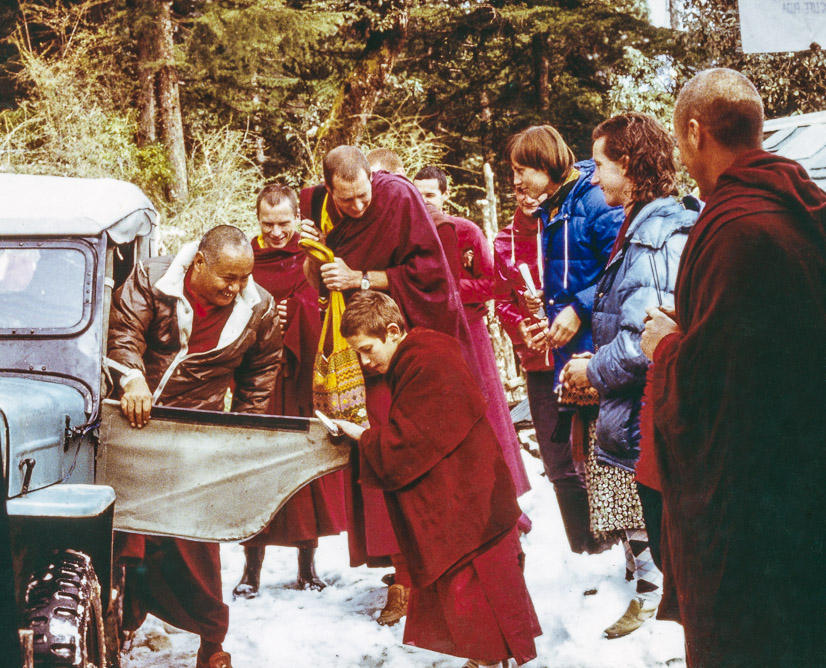
You people have to figure out for yourselves a constructive approach to all this. I am concerned for your welfare, but since I’m too ignorant to take care of even myself, how can I possibly know what’s best for your future?
Of course, we can quote Shakyamuni Buddha, where in one sutra he guaranteed that even if the amount of arable land on earth is reduced to the size of a fingernail, as long as his Sangha practice purely, they will never go hungry. Is that true or not? Come on! It can’t be true! Well, I don’t know if Lord Buddha was correct there or not. I have some doubt as to whether those words were true or not, because in my observation, many Sangha who have been practicing and studying sincerely have encountered trouble in getting the means of living, such as food, clothing and benefactors. Are there some who have experienced this kind of trouble? Well, in Western culture there’s no custom of sponsoring monks and nuns; it’s difficult. These days, even in Tibetan culture it’s difficult. It used to be that Tibetan monks and nuns had it pretty easy, but not any longer.
I don’t think we should go bananas worrying over whether or not someone will take care of us. These days all my Sangha are intelligent, they know what’s going on in the world; they are educated to a certain extent…at least to primary school level! So who worries? You people are capable of taking care of yourselves. We don’t need two or three of everything, but we do need to take care of our bodies and not get sick. You should take care of your body. You don’t need to think you’re a great meditator and try to lead an ascetic life, and thereby damage your nervous system. On the one hand, you talk about your precious human rebirth; on the other, you destroy your body. That’s stupid.
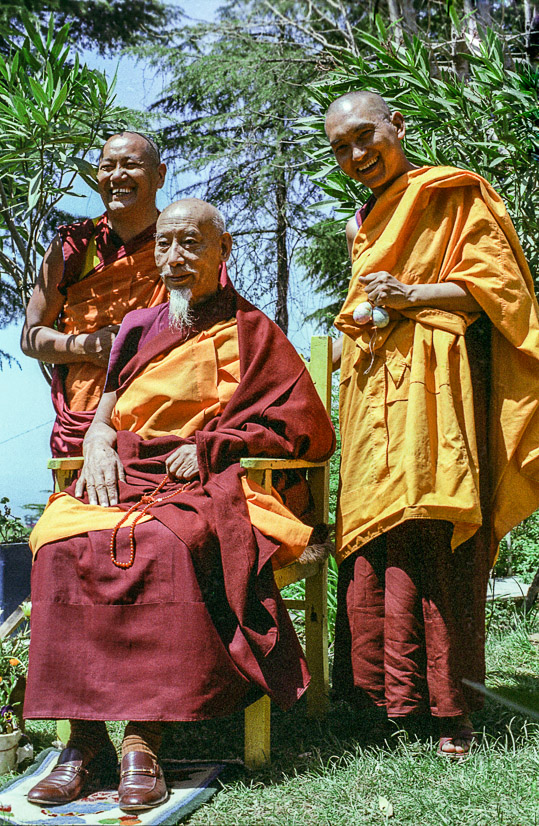
I am the Servant of Others
Monks and nuns should be practical in taking care of themselves, socially acceptable and work for the benefit of the majority. If the Sangha cannot work for the benefit of others, then what’s it all about? Honestly, you have to have the motivation, ‘‘I am the servant of others.’’ Perhaps, instead of OM MANI PADME HUM, that should be our mantra. We should repeat over and over, ‘‘I am the servant of others, I am the servant of others….’’ I think I’m going to make this the monks’ and nuns’ mantra, make them repeat it a million times; make them do the retreat of this mantra, ‘‘I am the servant of others.’’
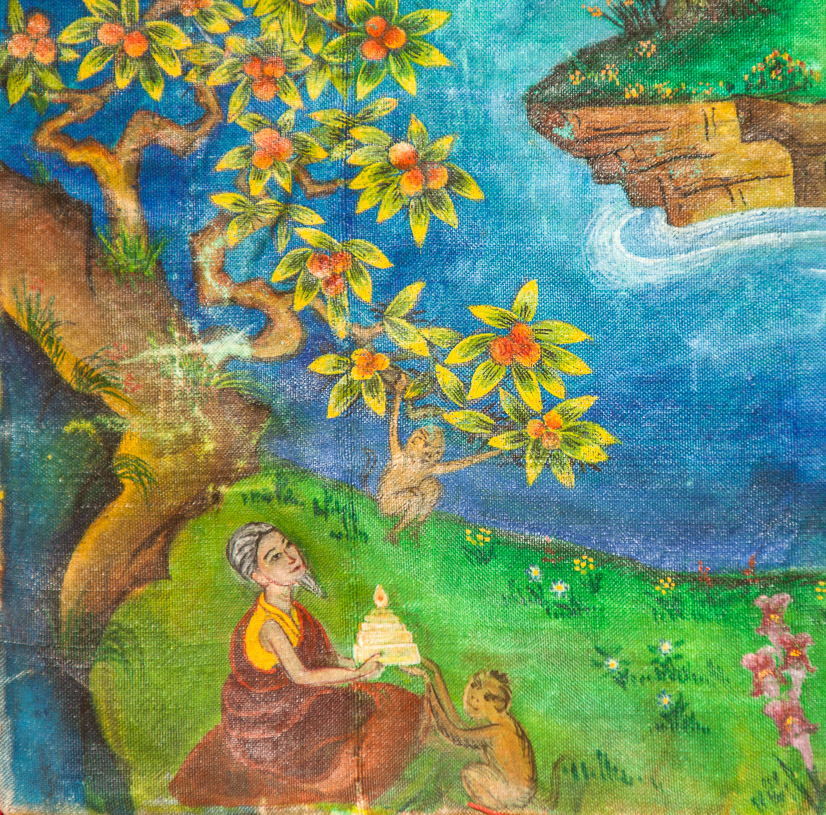
Sometimes monks and nuns have wrong conceptions. They consider that to be holy you have to live alone, leading an ascetic life. That’s not necessarily so; we don’t need to do that. Some people have this fantasy that by becoming a Tibetan monk or nun they have become some kind of great yogi. What makes a great yogi is dedication to others. Without dedication to others, there’s no way for you to become a great yogi or yogini. It’s impossible.
Maybe you think that serving others is impractical, that it doesn’t work. It works; it works. There is less pain in your mind. If somebody asks you for a cup of tea, for some help, instead of pain, anger and irritation, you feel bliss. If you get annoyed when someone asks for help, it shows you have no dedication.
You should be practical. Sometimes lay people criticize monks and nuns because they think they’re hopeless—they come home, eat and drink, but don’t do anything to help. They don’t even wash their own dishes; they leave them for others. They space out, say a few words about Dharma, blah, blah. Lay people don’t understand. That is Western culture.
I tell you, there is a big difference between the way Westerners look at Dharma and the way Eastern people do. Your parents don’t accept what you’re doing because they think you’re hopeless, stupid, not taking care of your life. That’s what they worry about. Your parents love you. They want you to be practical, to take care of yourself. Have you heard lay people criticize the Sangha? I have. They’re right, up to a point. Don’t think that we’re always right and lay people are always wrong.
Buddhadharma is practical, organic; it is something we can put into effect, here and now. Sometimes people have the misconception, ‘‘Ah, enlightenment is my goal,’’ and look up into the sky, hands folded at their heart. ‘‘Up there is my husband, that is my Buddha, that is my Dharma, that is my Sangha. I don’t care about anything down here.’’ I call that fanaticism; their feet aren’t on the ground. Be practical, OK? Fanaticism is ego, so arrogant, unreasonable, intangible; such people are simply dreaming. Perhaps it’s because in Tibetan Buddhism we say, For the sake of all mother sentient beings I should quickly become Buddha, therefore I’m going to practice…some sadhana or other. Maybe this sadhana way of thinking is a Western misunderstanding. I don’t know. Perhaps Mahayana Buddhism produces spaced out sentient beings instead of constructive organic flowers…or am I being too extreme?
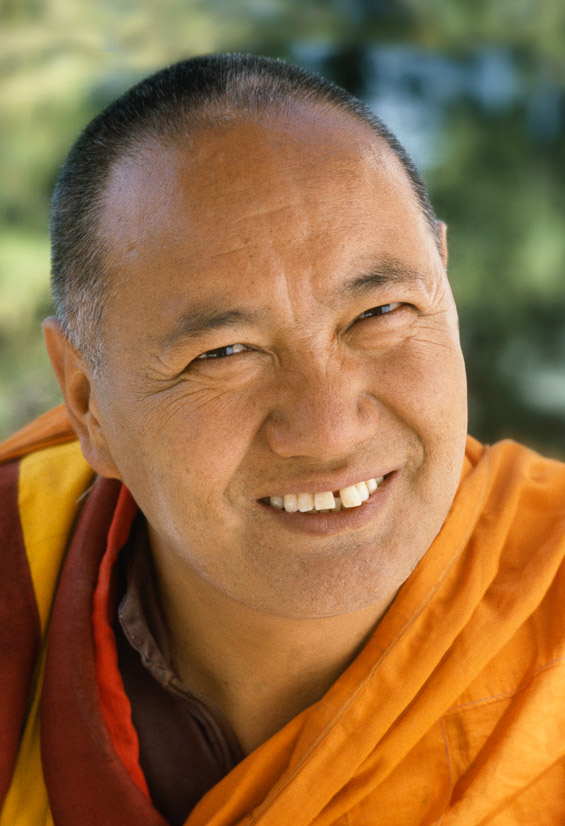
We should be aware of what lay people think. But I do understand that it can sometimes be a little paralyzing for a monk or nun to live in a community where the majority are lay people. You are the only one; you feel insignificant. You try to fulfill your Sangha obligations, but you are nobody. You try to compromise with the lay community, but that doesn’t work either. I do understand. I don’t want my Sangha to be put into that kind of situation, but environmental and economic realities sometimes force you into it. With Nalanda, we finally have an opportunity to live away from such situations, so now, at least, you won’t be able to blame the conditions for your difficulties. A monastic environment is extremely important.
Sometimes I get the impression that some of my Sangha think they won’t be able to keep their vows if they get a job; that if they work, they will become disasters as monks or nuns. That is a completely wrong attitude; it shows they are suffocated by ignorance. Not only are we human beings, but Lord Buddha has also given us method and wisdom. We should somehow be able to figure out how to put work and keeping our ordination together, so that we avoid that suffocating alternative. Many students have given me this impression. I don’t know if it’s a true picture or not.
Monasteries exist in the West. How do they do it? Those monks and nuns are human; they eat, they sleep, they work. That is a true picture. So why don’t we follow their example. Perhaps those Christian monks and nuns who work and still manage to keep their ordinations are more capable than we Buddhists. We should be ashamed of ourselves! Why don’t you all become Catholic monks and nuns? Then you’d have no problems. I’m joking!
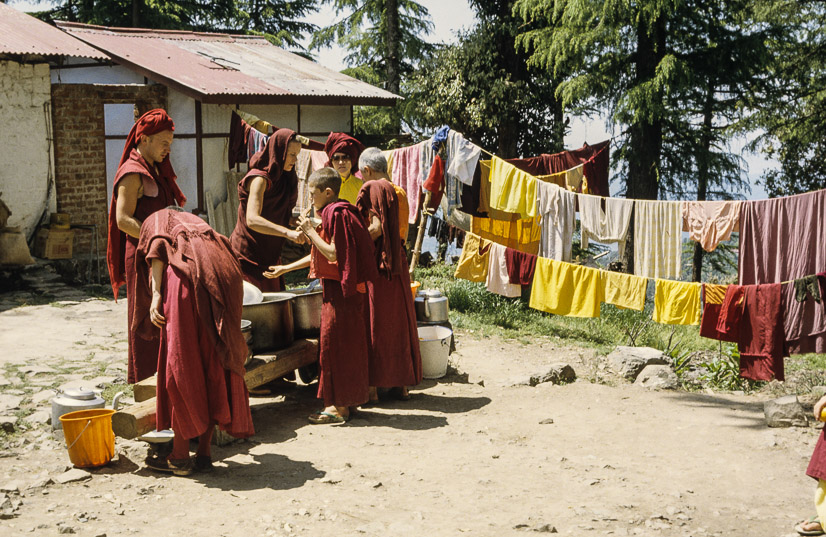
Anyway, what I am saying is that I want you to use your wisdom. I cannot tell you what to do. I do trust you to use your method and wisdom to come up with some way of establishing a Western monastery where we can both take care of ourselves materially and do our duty according to the vinaya. Can you motivate yourselves to accomplish this? I want you to generate a strong motivation, otherwise, we won’t make it. There are too many obstacles, too many hurdles. I expect mistakes to be made. Even in bringing Dharma to Tibet, many bodhisattvas were killed protecting their ordination. Do you know the history of Buddhism coming to Tibet? They were actually killed because they would not break their vows.
If you compare your situation to that when Dharma came to Tibet, you will see how lucky you are. You have much better facilities and education and far easier lives than they did back then. You people are incredibly lucky. But I still want each one of you to be very strongly motivated at a personal level: ‘‘I myself (not we, but I) am responsible for bringing Dharma to the West. I’ve understood that Lord Buddha’s wisdom is so powerful, it has brought me great satisfaction, and this is what the world needs more than anything else.’’
That doesn’t mean that you change completely overnight and tomorrow walk around like some crazy evangelist. Just be relaxed, but at the same time dedicated. Then you’ll be happy, no matter what sort of difficult situation you find yourself in—happy because you’re serving others. If you do not have dedication, every situation is painful for you because the fundamental human problem is the self-cherishing thought, not wanting to share anything with others, which is the very opposite of dedication. The dedicated attitude makes everybody brothers and sisters. Without it, others become thorns in your flesh; they hurt you, they hassle you, especially if you are living together with many other people. You feel others are a hassle, the place is so crowded, it’s like a concentration camp, Lama Yeshe is like a dictator, he comes around in the mornings saying do this and do that…. I am sure some of you might have had thoughts like this.
If you have a dedicated attitude, even should people accuse you of something or give you a hard time, it actually helps; it truly helps you. Personally, I really believe that we humans need to go through some hardships in order to develop understanding. If you’re always going around spaced out and everything’s too easy, you’ll never learn. I learned only because Mao Tse Tung put me into such a learning situation. Otherwise, I was pretty easy-going. As long as my parents and uncle were giving me everything, I never learned a thing. Later, I checked back to see if I’d learned any Dharma at that time. I hadn’t; I was just full of intellectual word games. Mao made me face real life. That time I learned a lot.
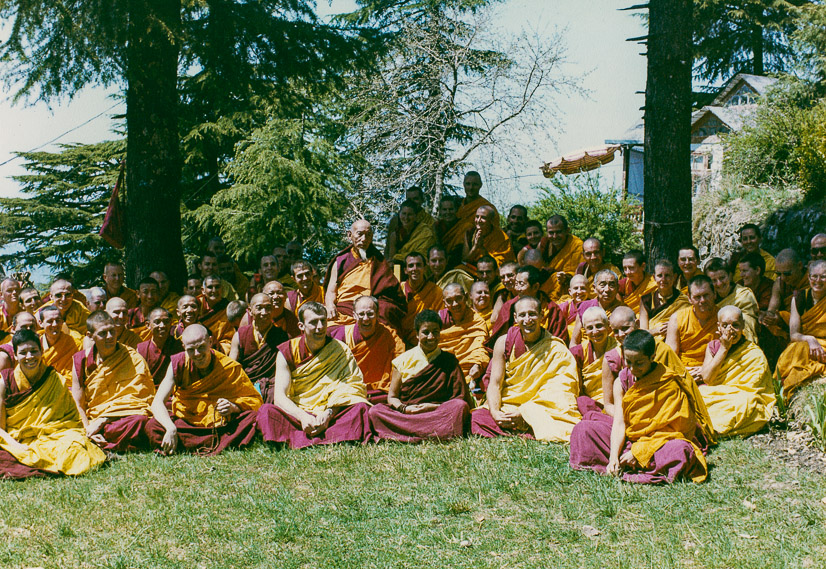
Gratitude for Sangha
That’s why I want you to be dedicated, but at the same time, happy. I don’t understand why you’re not happy. Being with each other, Sangha together, is such a warm, close feeling. I’m not a highly educated man, I’m not a highly realized person, but I feel so grateful just for the existence of other Sangha. We give each other strength. You have to understand, just by existing, you’re helping each other.
It seems that some of you don’t understand this. In other words, perhaps you don’t understand the value of Buddhadharma. Those who don’t feel that the Sangha community is so wonderful and that its members help each other don’t understand Buddhadharma; they don’t understand what is Dharma and what is not Dharma. Especially at times like this, when many monks and nuns have gathered together, you should recognize and respect them as actual Sangha. Perhaps you can’t respect each individual, ‘‘He is Sangha; she is Sangha,’’ and take refuge, but according to the vinaya you absolutely must respect the Sangha community as the Sangha object of refuge. When you received vinaya teachings from Tara Tulku in Bodhgaya recently, I’m sure he told you that four monks or nuns together are Sangha, didn’t he? Well, don’t just leave it at that. Inside your heart you should have the recognition, ‘‘That is the Sangha.’’ Then you will feel respect.
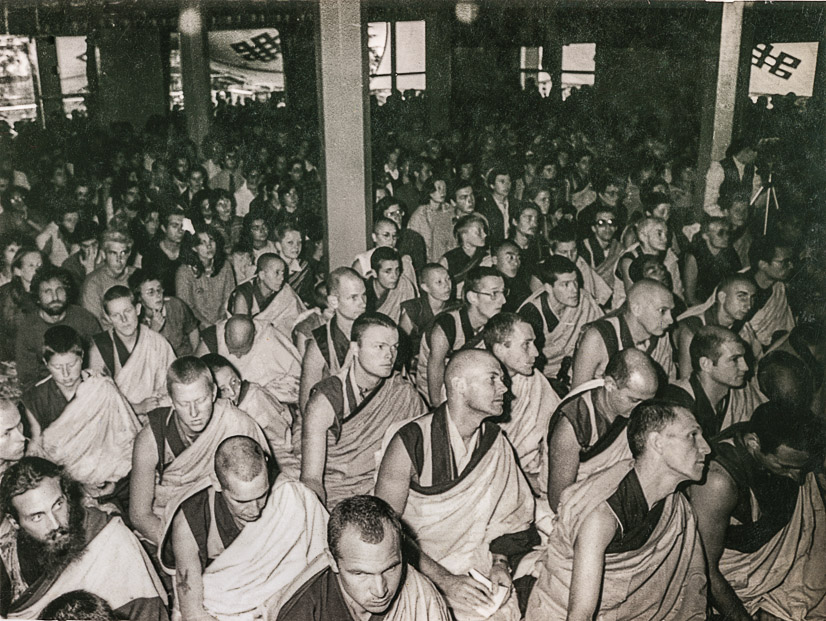
I feel that you are very fortunate just to have met other people who are at least trying to live in the thirty-six precepts of novice ordination. It’s unbelievable. In the world today, it’s so rare. Do you think those brothers and sisters trying to keep the thirty-six vows are rare or not? Yes, they’re rare. And if you understand the spiritual significance of this, you’ll understand how valuable they are. I want you to understand: you are my brothers, you are my sisters, you are my husband, you are my wife, you are my dollars, you are my precious possessions, you are my everything! Everybody understands the value of those things, don’t they? Well, each one of you is more valuable than all of those, more rare and precious than a million dollars. I feel I am so rich! It’s true; I’m not joking. I really believe this. You people should feel extremely fortunate just being in this kind of situation.
Look around—where on earth can you find such a situation? These days the world is becoming incredibly impure, full of garbage thoughts, superstition and mutual hatred, so at least you people should try to feel compassion and loving kindness for one another instead of seeing each other as heavy burdens. You are the most fortunate people in the world.
Look at your present situation. In the morning you go to puja and they serve you tea there. As soon as that’s over, your breakfast is ready. Then you go to teachings. After that, more tea is waiting. All you have to do is practice and take care of your mind; everything is there. Incredibly fortunate. Unbelievably fortunate. So, take advantage.
If you have a negative attitude toward a group of Sangha, that’s the worst bad karma you can create, I tell you. According to what I was taught, if you think, ‘‘I hate those international Sangha,’’ you are creating very heavy karma. From the Buddhist point of view, criticizing the Sangha is the most negative thing you can do. How do you know, amongst a group of Sangha, who is not a bodhisattva, who is not an arhat? I can’t tell. Complaining, ‘‘These Western Sangha, they’re no good, they’re this, they’re that…’’ is one of the worst things in the world you can do. You can point at individuals and say, ‘‘Lama Yeshe’s no good,’’ but when a group of seventy or eighty monks and nuns come together, how can you say they’re no good? That’s the heaviest karma you can create.
Honestly, I tell you, how many people in the whole world are keeping these thirty-six vows? How many are even trying? It is very, very rare. Normally we say that monasteries are so good. Monasteries are empty buildings. ‘‘Monasteries are good; monastery life is good.’’

An empty building is not a monastery. A monastery is good because a group of people is putting incredible positive energy into living in organic purity. Without people, it’s just concrete and wood. That’s not a monastery. Monasteries produce so many learned scholars, so many saints, because the people who live there help each other. Wood doesn’t produce scholars; water doesn’t produce saints.
Therefore, we’re establishing Nalanda Monastery to produce many saints and scholars. That’s why I called it Nalanda. We can be just like the ancient Indian monastery Nalanda, which produced such great Indian pandits as Atisha, Naropa and Shantideva. I really feel that our own monastery can produce such saints and pandits. I think so. I don’t worry that the intellectual clarity of Buddhadharma can’t reach the Western world. Westerners can comprehend anything that Tibetans can.
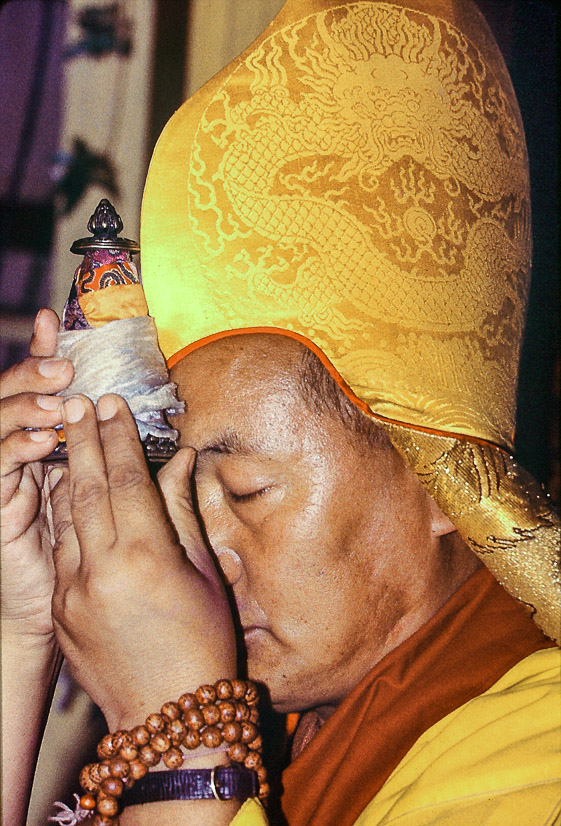
More Resources for Study
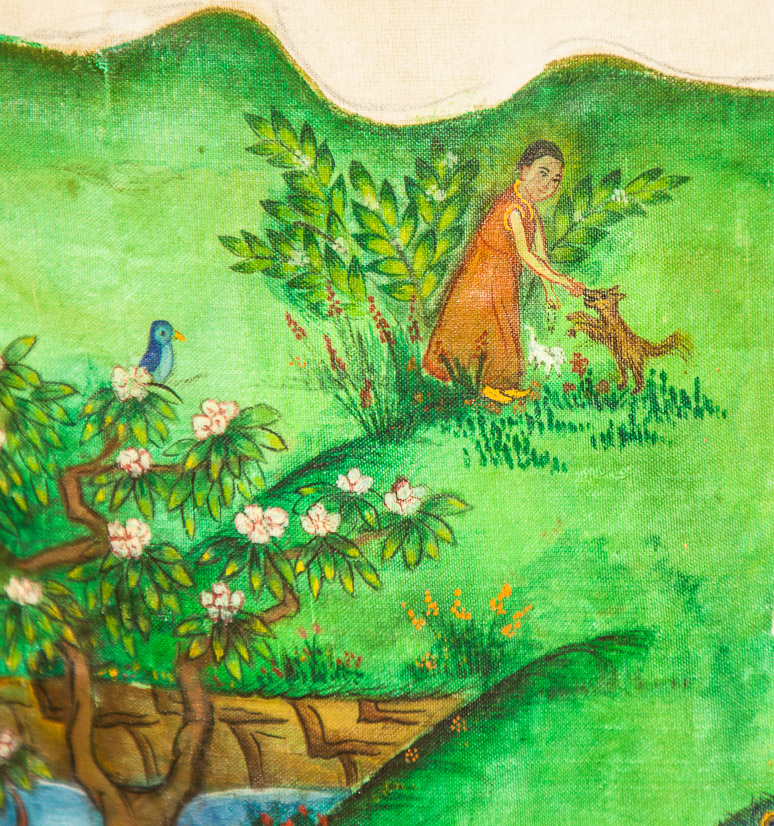
Big Love: The Life and Teachings of Lama Yeshe
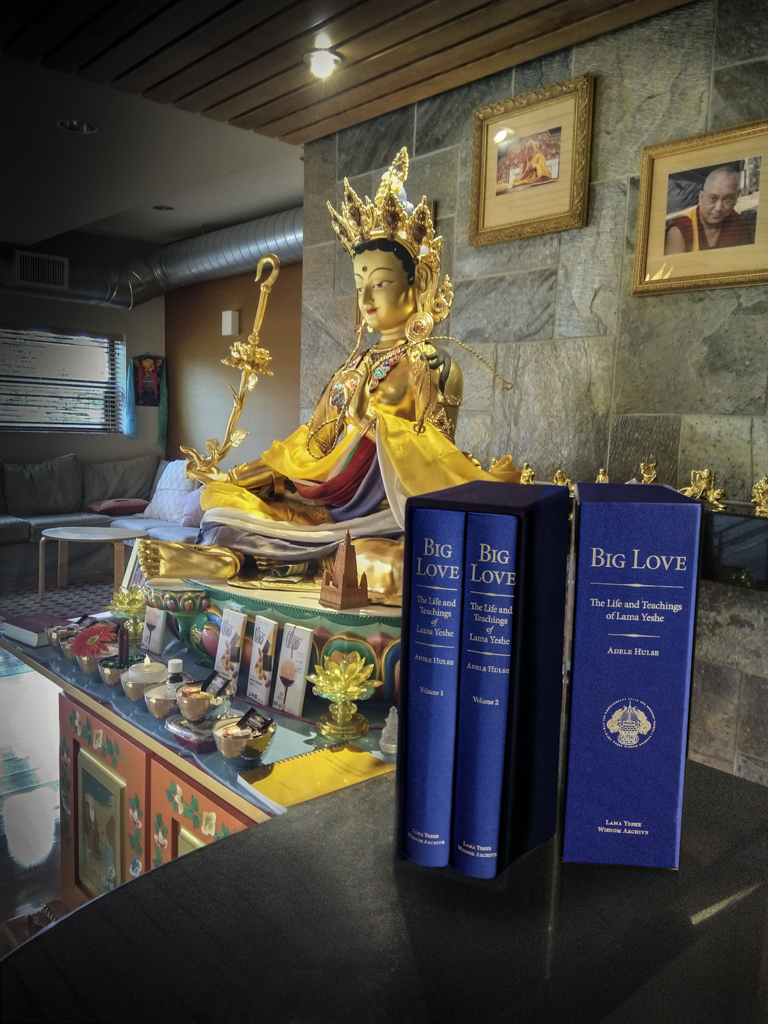
Big Love: The Life and Teachings of Lama Yeshe
Big Love, the official, authorized biography of Lama Yeshe, contains personal stories of Lama Yeshe and Lama Zopa Rinpoche and the students who learned, lived and traveled with them, as well as more than 1,500 photos dating back to the 1960s. The full range of events during the first Enlightened Experience Celebration, including the teachings you just explored in this multimedia presentation, are described in exquisite detail in Big Love, Volume 2, Chapter 20. “1982: A Celebration of the Enlightened Experience.” We invite you to watch the following video to learn more about Big Love and to visit our website to order a copy for yourself or as a gift.

Video: The Big Love of Lama Yeshe
Watch this short video about Big Love: The Life and Teachings of Lama Yeshe.
About Nalanda Monastery
Nalanda Monastery provides a supportive environment in the West for monastics of Tibetan Buddhism in the tradition of Lama Tsongkhapa as taught by the founders of the FPMT organization — Lama Thubten Yeshe and Lama Zopa Rinpoche, to study, practice, serve and inspire all sentient beings under the guidance of our Spiritual Director, Kyabje Zopa Rinpoche. Nalanda aims to bring about progress in universal wisdom, altruism and compassion through an example of moral conduct and by upholding the teachings of the Buddha. Nalanda seeks to offer a warm welcome, service or guidance to everyone who interacts with its community.
Advice for Monks and Nuns
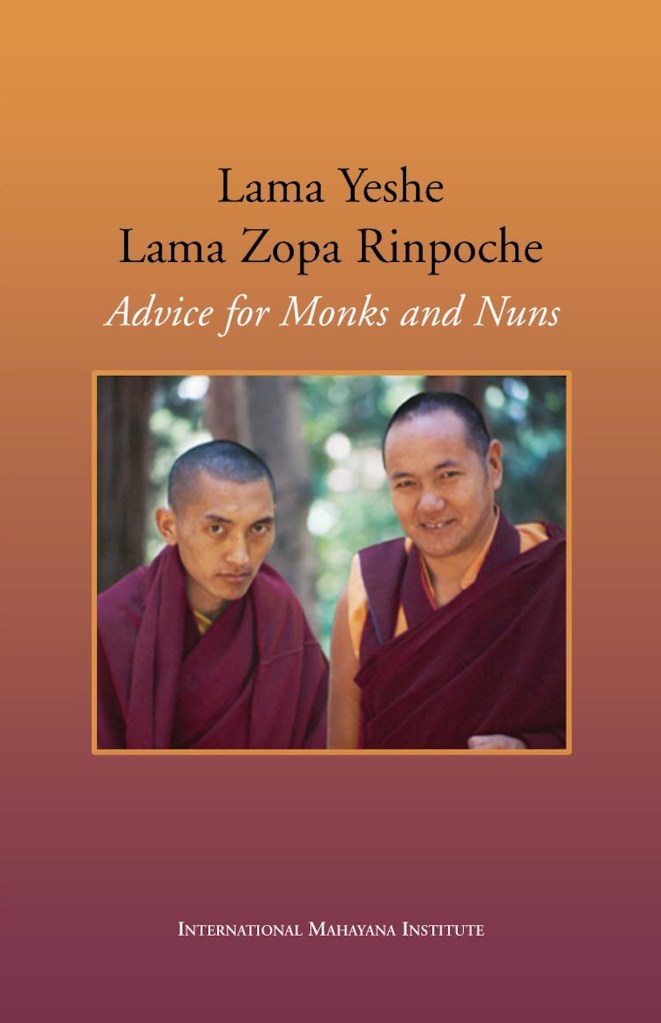
In these talks, Lama Yeshe and Lama Zopa Rinpoche explain the great benefits of practicing Dharma as an ordained person, how to keep the ordination pure, the purpose of the monastic community, how to live together as monks and nuns, and much more. The necessity for the lay community to support the Sangha is also made clear, and not only monks and nuns but lay practitioners, too, will gain much by reading Advice for Monks and Nuns.
About FPMT Education
Education is the very heart of FPMT. Through comprehensive study programs, practice materials, training programs, and scholarships, FPMT Education nourishes the development of compassion, wisdom, kindness, and true happiness in individuals of all ages. We offer a vast range of education programs, fulfilling the needs of beginners to advanced practitioners.
Additional Image Credits
Cover image: Lama Yeshe on the new retreat house balcony, Tushita, 1982. Jorge Zontal (photographer)
“I am the Servant of Others”: Lama Yeshe and Lama Zopa Rinpoche with Zong Rinpoche, Tushita Retreat Centre, Dharamsala, India, 1982.
“Gratitude for Sangha”: International Mahayana Institute sangha with Zong Rinpoche, Tushita Retreat Centre, Dharamsala, India, 1982. Wendy King (donor)
“More Resources for Study”: Scene from Jampa Chökyi’s Tara Cittamani thangka, 2019. Dionne Wilson (photographer)

About LYWA Multimedia
All of us here at LYWA hopes that these multimedia presentations will serve to immerse you in these precious teachings and will enhance your meditation and practice. By weaving Archive resources together in this multidimensional way we intend to offer you the means to deepen your experience of the teachings – almost as if you had attended the teachings in person.
This multimedia version of Lama Yeshe’s The Advantages of Monastic Life adds to our growing collection of multimedia titles including Lama Yeshe’s How to Meditate and Freedom – Courage – Realization, Lama Zopa Rinpoche’s The Merely Imputed I, the Bodhisattva Attitude multimedia series beginning with Everything Depends on Your Attitude and the Guru Puja is the Heart Practice series.
Explore the complete collection of LYWA multimedia titles here.
We welcome your questions, comments and suggestions.
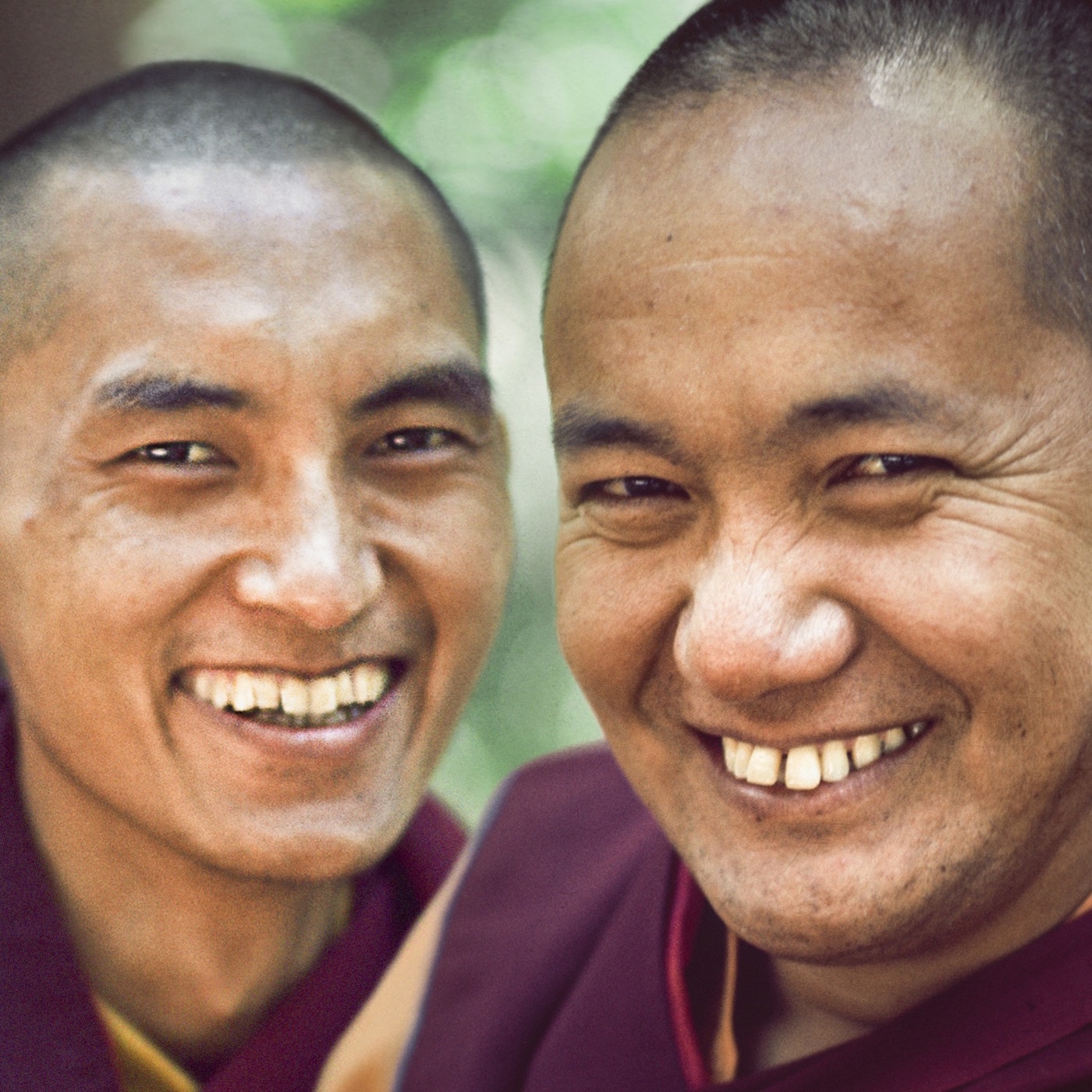
The Lama Yeshe Wisdom Archive
These multimedia titles are made possible by the kind supporters of the Lama Yeshe Wisdom Archive who, like you, appreciate how the Archive makes the teachings of Lama Yeshe and Lama Zopa Rinpoche freely available in myriad formats on the LYWA website for researching, listening, reading, downloading and ordering, shared daily with our social media communities and distributed worldwide as audio books, ebooks and many free books.
Please join us in sharing the Dharma with everyone everywhere for the happiness and benefit of all beings. Learn how by visiting us at LamaYeshe.com.
Thank you so much!
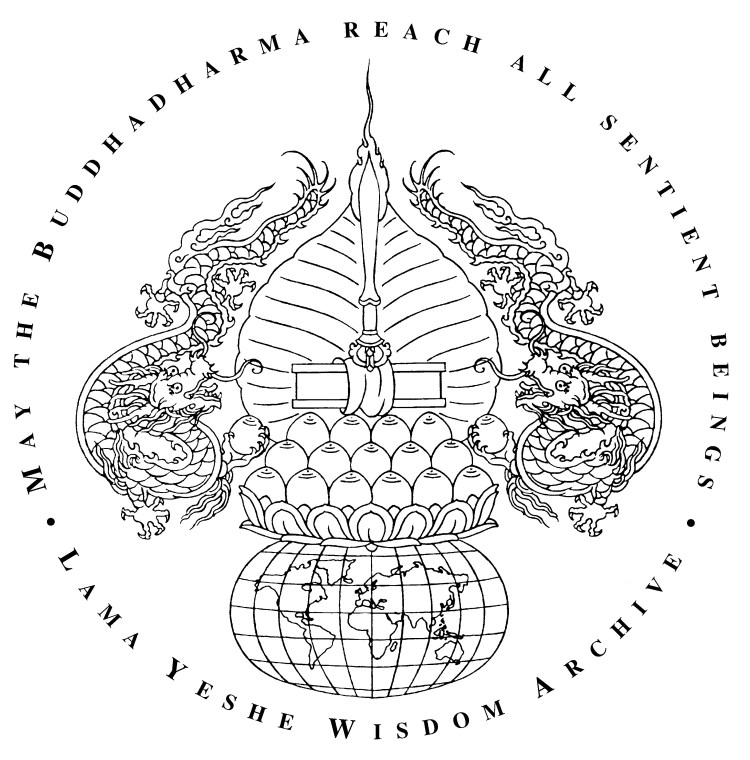
Sign up for the LYWA E-letter
Sign up for the LYWA e-letter and receive a monthly message with a newly edited teaching from Lama Yeshe or Lama Zopa Rinpoche, news about the work of the Archive, and links to great resources on the web.

